Global financial markets reacted negatively to the high tariffs imposed by President Donald Trump’s administration. Asian stock markets fell sharply, the dollar weakened against the euro and gold prices set a new nominal all-time record.
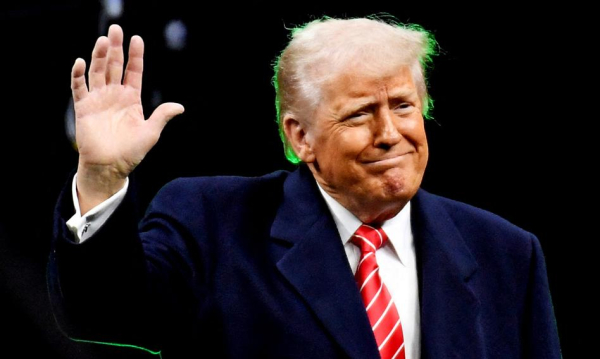
Contrary to what the American leader said, these were not “friendly tariffs”. The rates proposed by the White House start at 10% (this is the new minimum import tariff in the US), but in many cases they reach 20-35%). It is difficult to expect that such tariffs will not meet with a hostile response from such highly taxed nations. The risk of a global tariff war has become very real.
Investors were quick to react. Since President Trump's speech came after the regular session on Wall Street, futures markets were the first to react. Nasdaq futures were down 3.5% in the morning, while S&P500 futures were down nearly 3%. This heralds significant declines at the opening of Thursday's cash session in New York.
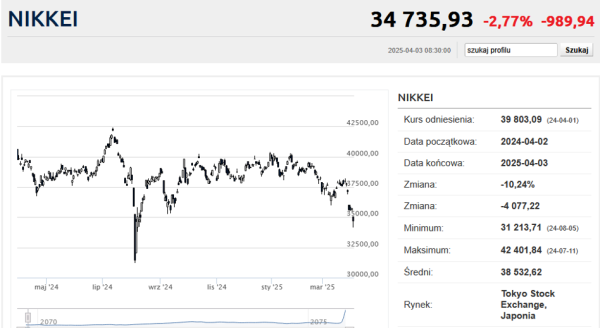
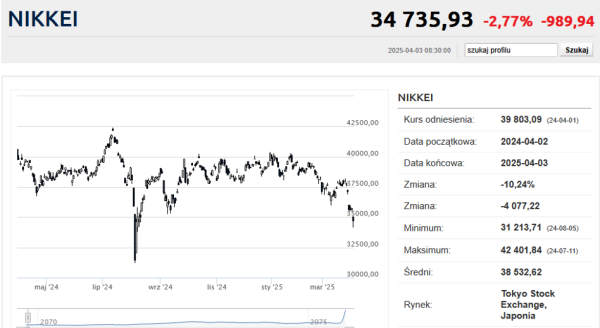
In Asia, Japan's Nikkei ended the day down 2.8%, hitting its lowest level since the August crash. Hong Kong lost 1.6%, Seoul lost 1.2%, but outside the Philippines, other Asian markets lost less than 1%.
The debt market saw a significant increase in the valuation of US government bonds, for which new tariffs mean higher tax revenues, (ceteris paribus) a smaller budget deficit and a smaller supply of new bonds. The yield on 2-year Treasuries fell to 3.8% and was the lowest since October. 10-year securities were quoted at a YTM yield of 4.05% – also the lowest since the November presidential elections in the United States.
The dollar, on the other hand, was clearly losing ground. The EUR/USD rate shot up, rising from around 1.078 to 1.098 on Thursday at 8:51. These are the highest quotes for the euro-dollar pair in six months. The Polish currency market was relatively calm. The euro cost 4.1763 PLN, similar to the previous day. On the other hand, the dollar fell by over 5 groszy, dropping below 3.80 PLN and reaching the lowest rate since September last year.
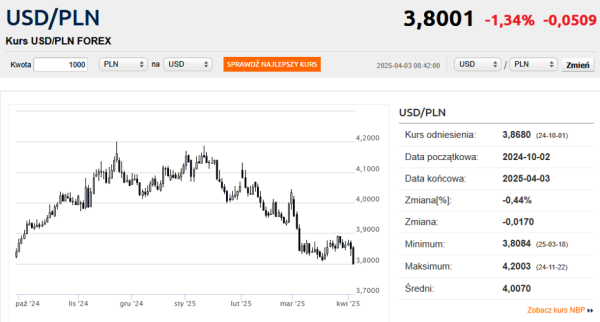
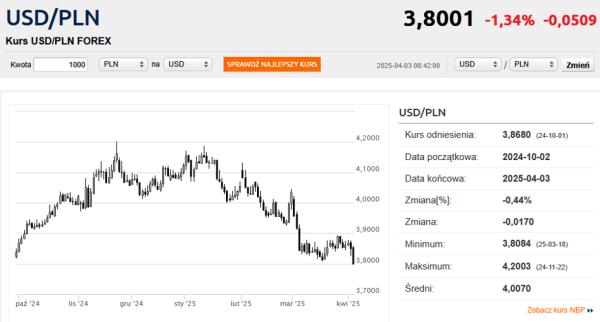
Dollar gold prices reached a new all-time high overnight, reaching the level of USD 3,192.49 per ounce. But later the royal metal began to fall and on Thursday morning it was valued at USD 3,146.84/oz. Silver prices fell by as much as 4.7%, while platinum and palladium lost more than 2%. Most of the main industrial raw materials were in the red. Copper and aluminum prices in London fell by 1.5%, and Brent oil fell by 1.2%.
The Thursday session on the Warsaw Stock Exchange also started with declines. A few minutes after the opening of trading, WIG20 fell by 1.67%, reaching 2702.05 points. WIG lost 1.5%, mWIG40 over 1%, and sWIG80 went down by 0.75%. This is therefore a much weaker reaction than in the case of markets in Japan and contracts on New York indices.
Among Polish blue chips, the worst performers were LPP shares, which fell by around 6%. The clothing company disappointed investors with its results for Q1, which would explain such a deep sell-off. In addition, for global reasons (sell-off of industrial raw materials), JSW and KGHM shares did poorly, falling by around 2%. The only positive performers were PGE shares (+0.9%).
The main stock market indices in Europe also turned red. At the beginning of Thursday's session, the German DAX was down 2.2%, the French CAC40 by almost 2%, the Italian MIB by 1.8%, but the London FTSE100 was only losing 1.1%.
KK





